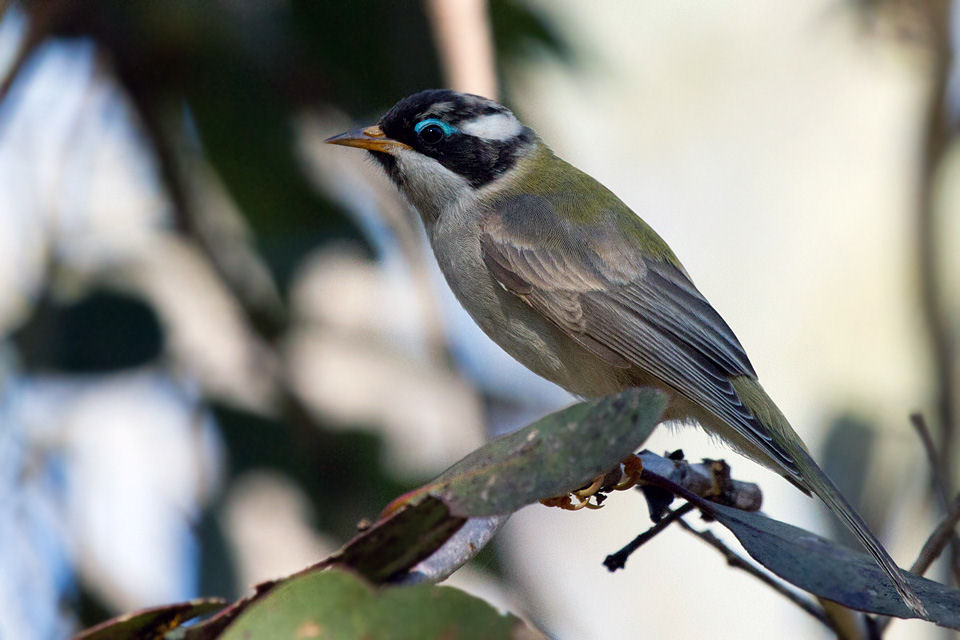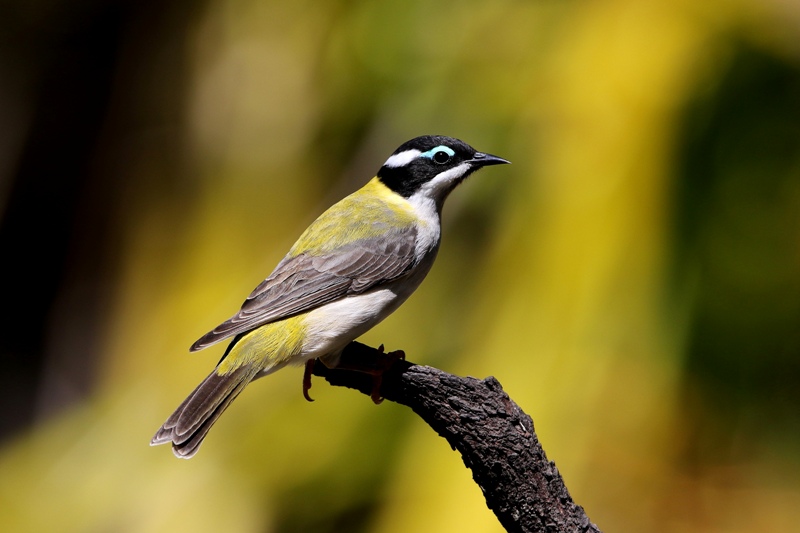
Blackchinned Honeyeater in Victoria Australia Stock Image Image of avian, warren 268570059
Averaging 17cm in length, the black-chinned honeyeater is one of largest honeyeaters. This bird has a black 'cap' which intersects with a white crescent around the nape of the neck. It also has a distinctive black 'chin' beneath the bill extending down the white throat, and dull olive-green and white wings with a grey tint on the underside.

Blackchinned Honeyeater [Bushpea 9/14] Large
The black-chinned honeyeater ( Melithreptus gularis) is a species of passerine bird in the family Meliphagidae. It is endemic to Australia. Two subspecies are recognised. Its natural habitats are temperate forests and subtropical or tropical dry forests. Taxonomy

Blackchinned Honeyeater in Victoria Australia Stock Photo Image of laetior, warren 268570084
Black-chinned Honeyeater Melithreptus gularis Scientific name definitions. Names (16) Subspecies (2) Peter J. Higgins, Josep del Hoyo, Nigel Collar, Les Christidis, Guy M. Kirwan, and Hugh Ford Version: 1.0 — Published March 4, 2020 Text last updated June 8, 2017. Sign in to.

Blackchinned Honeyeater in Victoria Australia Stock Photo Image of exotic, fauna 268570086
Species details Kingdom Animalia (animals) Class Aves (birds) Family Meliphagidae (honeyeaters and chats) Scientific name Melithreptus gularis (Gould, 1837) Common name black-chinned honeyeater WildNet taxon ID 1483 Nature Conservation Act 1992 (NCA) status Least concern Conservation significant No Endemicity Native Pest status Nil

Blackchinned Honeyeater in Victoria, Australia Stock Image Image of melithreptus, colorful
Black-chinned Honeyeater Melithreptus gularis. Family: Honeyeaters. Status in the ACT: Non-breeding vagrant. Eastern sub-species declared Vulnerable in NSW. PDF Data Sheet [Show slideshow] Injured Native Birds Contact: ACT: ACT Wildlife 0432 300 033 NSW: Wildcare 6299 1966

Blackchinned Honeyeater eBird
The black-chinned honeyeater ( Melithreptus gularis ) is a species of passerine bird in the family Meliphagidae. It is endemic to Australia. Two subspecies are recognised. Its natural habitats are temperate forests and subtropical or tropical dry forests. Te Terrestrial No Nomadic B starts with Appearance

Richard Waring's Birds of Australia Blackchinned Honeyeater at Ellery Creek
Meliphagidae (honeyeaters and chats) Scientific name Melithreptus gularis gularis Gould, 1837 Common name black-chinned honeyeater (eastern) WildNet taxon ID 22457 Alternate name(s) black-chinned honeyeater black-chinned honeyeater (black-chinned) Nature Conservation Act 1992 (NCA) status Least concern Conservation significant No Endemicity.

Blackchinned Honeyeater ZooChat
Black-chinned Honeyeater Isa. The sub-populations in AMLR may have been isolated historically (Schodde and Mason 1999).3 Declines have occurred over most of its national range. Estimated extent of occurrence is 420,000 km2 and decreasing. Estimated area of occupancy is 40,000 km2 and decreasing.

Blackchinned Honeyeater The Australian Museum
Medium-sized honeyeater with a black hood and tiny black mark on chin. There are two subspecies which have significant visual differences. The subspecies in southeastern Australia has an olive back and blue skin around the eye. The

Honeyeater, Blackchinned Central QLD Coast Landcare Network
The Black-chinned Honeyeater is the largest of its genus, reaching 17 cm in length. The cap is black, with a white crescent around the nape, and there is a diagnostic black 'chin' beneath the bill and extending down the white throat (though this can be difficult to see in the field). There is a small crescent of blue skin above the eye.

Blackchinned Honeyeater Australia Awesome Birds Pinterest Australia, Bird and
The black-chinned honeyeater (Melithreptus gularis) is a species of passerine bird in the family Meliphagidae. It is endemic to Australia. Two subspecies are recognised. Its natural habitats are temperate forests and subtropical or tropical dry forests.

Blackchinned Honeyeater (Melithreptus gularis)
Black-chinned Honeyeater (eastern subspecies) ( Melithreptus gularis gularis ) Download strategy (PDF) Registered users New search Saving our Species strategy This species has been assigned to the Landscape species management stream under the Saving our Species (SoS) program. Justification for allocation to this management stream
.jpg)
BirdLife Melbourne New Holland Honeyeater
Black-chinned Honeyeater Did you know? When choosing hair or fur to make its nest the Black-chinned Honeyeater tends to choose pale colours, plucking the white or cream hairs from cattle and horses (and even from a cat), as well as wool from sheep. Calls Loud churring or scratchy 'creep-creep-creep'. Also gives beautiful, complex song. play stop

Blackchinned Honeyeater a photo on Flickriver
Black-chinned Honeyeater - The Australian Museum When choosing hair or fur to make its nest the Black-chinned Honeyeater tends to choose pale colours, plucking the white or cream hairs from cattle and horses (and even from a cat), as well as wool from sheep.

Blackchinned Honeyeater (Melithreptus gularis) Pet birds, Nature birds, Most beautiful birds
Black Honeyeaters, especially females, often eat charcoal and ash at old camp-fire remains.

Blackchinned Honeyeater (Goldenbacked) eBird
The Black-chinned Honeyeater (Melithreptus gularis) is one of three species of white-naped honeyeaters in the genus Melithreptus found in Victoria, others being the Brown-headed Honeyeater Melithreptus brevirostris and the White-napped Honeyeater Melithreptus lunatus.